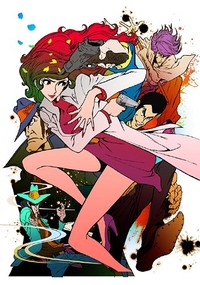Shelf Life
Flowers for Fujiko
by Erin Finnegan,

anohana: The Flower We Saw That Day complete BD+DVD
Rental Shelf
Dream Eater Merry complete DVD
Perishable
None this week
Stream Worthy
Lupin III: The Woman Called Fujiko Mine ep. 1-13
After King of Pigs I went straight home to watch the end of anohana, turning the weekend into an emotional roller coaster.
 If you pitched anohana to me and I wasn't writing Shelf Life, I wouldn't want to watch it. A group of friends reunited in high school, reminiscing about their dead friend from elementary school? I mean what is this, The Big Chill of anime?
If you pitched anohana to me and I wasn't writing Shelf Life, I wouldn't want to watch it. A group of friends reunited in high school, reminiscing about their dead friend from elementary school? I mean what is this, The Big Chill of anime?Jinta "Jintan" Yadomi thinks he's hallucinating when his dead childhood friend Menma's ghost leaps on him one summer. At first I worried that Menma was the ghost of Jinta's dead sister, which is another show I wouldn't want to see.
The only person who can see Menma is Jinta, and it takes Jinta several episodes to admit to his group of former elementary school friends, “The Super Peace Busters,” that Menma's ghost is among them.
Menma can touch objects and appears very solid. However, we never get to see the objects Menma is manipulating from outside of Jinta's perspective, so we don't see things floating through the air.
I was hooked by episode three. One of the Peace Busters, Tetsudō "Poppo" Hisakawa, claims to have seen Menma's ghost near their old hideout in the woods. Caught up with the excitement, Menma wants to help the friends Ghost Hunt… for her. A ghost's ghost? Episodes two and three were so funny and lighthearted that the series completely won me over.
The Super Peace Busters haven't just drifted apart, they were all messed up by Menma's death. Jinta has practically dropped out of school, Naruko "Anaru" Anjō hangs out with gal-like semi-delinquent types, Poppo lives in the shack they used to hang out in and works part time jobs around the world instead of going to high school, and Yukiatsu and Tsuruko have their own Menma-triggered hang-ups. No one has mourned properly and no one can move on.
Menma doesn't know why she's appeared back on earth, and she doesn't know how to pass on to the next life either. She thinks she had a wish when she died that she's forgotten, so the characters spend a lot of time anticipating that wish (did she want to find a rare Pokémon?) and trying to grant it so Menma can move on. In the process, the Super Peace Busters are forced to reunite.
For being dead, Menma can be hyperactive at times. In a poorly directed show, she would've been annoying. Menma was practically the perfect little girl when she was alive—a super-cute, selfless kid. All of the male Peace Busters were totally in love with her, and the girls, Anaru and Tsuruko, were jealous. Menma was almost too good to be true, and all her friends knew it.
This is a very different show from most contemporary anime series. The characters have depth! They are real characters who grow and change! Plus anohana never resorts to clichés. Menma never follows Jinta to school like you'd see in another series. In fact, I was impressed at the amount of time Jinta (and Anaru) spend skipping school. Maybe there aren't truancy laws in Japan like there are in the U.S.
It's even well animated! My only complaint about anohana is that the ending is dragged out. It's about an episode and a half too long. The extra length is indulgent -- it's not fanservice exactly, it's more like, let's say, “human service.” That is to say, since death is often unpredictable, we as humans rarely get the chance to say goodbye to friends or loved ones exactly the way we'd like. In that regard, the end of the show feels like a kind of human wish fulfillment.
I almost wish the ending was more cruel, although I know that makes me sound like a horrible person. I think there's a trend in “healing” anime as a sort of sub-genre. anohana is the only thing I've seen that might count as healing that I'd recommend to other people. Don't miss it.
The included artbook translates Jinta's T-shirt collection, but isn't too exciting otherwise.[TOP]
I hit the jackpot with good, solid, recommendable anime this week, as I also watched The Woman Called Fujiko Mine.
 Lupin III: The Woman Called Fujiko Mine is easily my favorite show of last season. It may be my favorite Lupin adaptation after The Castle of Cagliostro. This is certainly the most pleasing adaptation of Fujiko as a character that I've ever seen.
Lupin III: The Woman Called Fujiko Mine is easily my favorite show of last season. It may be my favorite Lupin adaptation after The Castle of Cagliostro. This is certainly the most pleasing adaptation of Fujiko as a character that I've ever seen. All I expected from Fujiko based on early reports was a lot of nudity, and indeed, there are a lot of nude breasts in this show. (Maybe I'm desensitized to boobs after a lot of HBO and ero-com anime.) If you're totally transfixed by Fujiko's nipples, you're going to miss some super sweet font choices in the opening credits.
This is worth watching for the line quality alone. Fujiko Mine is drawn in all thick black lines that fall somewhere between Record of the Lodoss Wars and Requiem from the Darkness, but unlike in Lodoss Wars, the lines are free to move, thanks to some expert 2D CG work from Production I.G None of the shadows are done in the usual way; instead, shadows are indicated through short straight lines, similar to comic cross-hatching or stippling. I could watch this show just for the shadows. Some of the crazier color work, particularly in Fujiko's flashbacks, has a very Madoka Magica quality to it (like a dark Yellow Submarine).
I'm already in love and I haven't even gotten around to the plot. In this alternate universe Lupin-spin off, Fujiko is the main character. As always, she's a master thief and master of disguise. A number of the first eight-ish stand-alone episodes start off with Fujiko posing in as variety of different jobs: a governess to some rich kids, a teacher at an all girl school, a journalist sent to interview a thinly-veiled Fidel Castro (that episode - "Music and Revolution" – is particularly good)… but no matter Fujiko's job title, everyone around her falls in love with her. She beguiles people and steals their treasure with a smile. Theft, as she says in the opening narration, is Fujiko's “sexy prison”.
We're slowly introduced to Lupin, Jigen, Goemon, Zenigata, and a new character named Oscar who works as Zenigata's lieutenant. Unlike in Lupin the 3rd (as you may remember from Cartoon Network), the characters don't come together for heists until the end. The relationships between the characters are played up in a way that nearly veers into fanservice territory, but pulls it off with class. (The next best comparison I can think of is the 2009 Star Trek reboot film.)
Fujiko Mine is fun to watch in part for the high stakes, high concept adventures in exotic locales. There are battles on planes, on trains and inside of pyramids. Our thieves face off against with teen girls shooting machine guns and terrorist bombs in Paris. Episode nine features Fujiko running along a cable car wire like some kind of Terminator.
The show nods smartly to other anime series. Episode six at the girls school is a smart send-up of Maria Watches Over Us with winks at Oniisama E... . Oscar's flashbacks are done in Utena-like shadow plays. (This is a series for mature audiences where “mature” means you're old.)
The ending is brilliant. Without spoilers, I will say that it involves a lot of creepy owls. (“The owls are not what they seem,” as on Twin Peaks.) There are a lot of layers and at least one red herring, making the finale smart enough to warrant analysis that would be sadly too long to include in Shelf Life. I strongly encourage you to write such analysis (and tell me about it on Twitter), and be sure to mention that the series boasts both a female director (unheard of in anime) and a female head writer (equally rare).[TOP]
I can think of very few anime series that have such satisfactory conclusions as Lupin III: The Woman Called Fujiko Mine. I probably will never know if Dream Eater Merry concludes satisfactorily, as I've been renting it…
 I first learned about baku, the Japanese dream eating demon, from the manga of the same name, which I reviewed in my earlier, angrier, manga-reviewing days.
I first learned about baku, the Japanese dream eating demon, from the manga of the same name, which I reviewed in my earlier, angrier, manga-reviewing days.Merry Nightmare is a baku from the dream realm who's wound up homeless in the Real World, and is taken in by Yumeji, a high school kid who can predict the sorts of dreams people will have that night by more or less reading their auras. Merry would like to get home, but as long as she's trapped in reality she's happy to help Yumeji free humans enslaved by dream demons. Subsequent early episodes seem to take on a monster-of-the-week format, framed with an over arcing plot about a villain in Yumeji's reoccurring nightmares.
Dream Eater Merry has surprisingly high production values, or at least surprising to me, because based on the title and trailers (or lack thereof; thanks, Sentai Filmworks), I had low expectations of this show. The art style is appealing enough, with Merry appearing like some nightmarish Strawberry Shortcake (cool) and some interesting color effects that separate dreams from reality.
There is also a surprisingly high quality dub, with Hilary Haag delivering a very believable performance as Merry. Between the good dub, slick production values, and solid character design, this ought to be a better show. As a monster fighting show, it lives and dies based on its combats, but I wasn't interested in any of the battles at all. Maybe the action was handled poorly, or maybe I couldn't bring myself to care about Yumeji helping a girl recover her dream of becoming a nurse. I wasn't interested in the main characters, let alone the one-off side characters they have to save.
I'm particularly uninterested in Isana Tachibana, Yumeji's childhood friend who he lives with. She acts like the caring younger-older-sister, which is a type and not a real character. “Nurturing” is not a personality, let alone a well-rounded character. Yumeji is also relatively personality-free, which comes through in Blake Shepard's generic (yet spirited) performance as An Anime Protagonist. Only Merry, with her freak rectangular-pupil goat-like eyes, seems to have any character at all.
Maybe I got to Dream Eater Merry in a bad week. If the other two series I saw this week were Yuruyuri and Girls Bravo I might have looked more favorably on it. Sorry, Merry. You'll have to try harder than that.[TOP]
Oh well. I'll see you guys next week. I'm not sure what I'm watching yet.
Just a heads up, there will be no Shelf Life on July 30th because I'm going to Otakon.

This week's photos are from Brad Clark:
"These pics aren't nearly as impressive as some that are featured in this column- the shelves are only for DVDs, and I no longer have the display space for the handful of manga or figures I collect (their storage boxes are quite underwhelming). I've probably spent more money than I should in my quest to fit as much as possible on these two shelves- from double and/or triple-dipping when a Complete Collection comes out, to buying bulk boxes of thin-pak cases and repackaging most of my singles. I'm another of the older fans that's been collecting on and off since the days of VHS, but have only started to expand my library in earnest in the past five years or so..
Non-anime DVDs and old console games are separate but equal (apologies to the civil rights movement) in their own corner of one of the units."


Thanks! Still impressive!
Want to show off your stuff? Send your jpgs to [email protected].
discuss this in the forum (73 posts) |